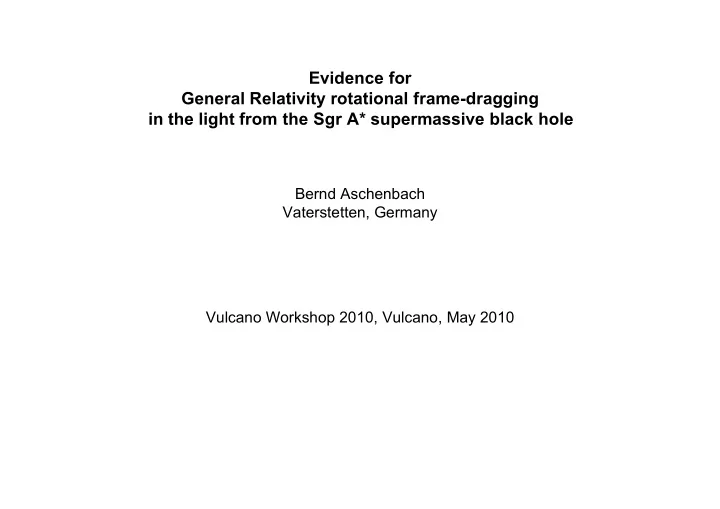

Evidence for General Relativity rotational frame-dragging in the light from the Sgr A* supermassive black hole Bernd Aschenbach Vaterstetten, Germany Vulcano Workshop 2010, Vulcano, May 2010
THE OPTICAL APPEARANCE OF A STAR ORBITING AN EXTREME KERR BLACK HOLE C.T. CUNNINGHAM & J.M. BARDEEN, ApJ 1972 & 1973 Some of their conclusions: 1.) `` … There is a denumerable infinity of such images since trajectories which pass close to the black hole may circle the black hole any number of times. However, unless the star is very close to the black hole, only two or three images will be significantly bright. … `` 2.) `` … The focusing of light is particularly strong when the observer is close to the equatorial plane and the star is behind the black hole. …. `` 3.) `` … Stars near the black hole would appear to pulsate … `` 4.) `` … The light curve … for the image caused by orbiting photons shows a surprising characteristic: it doubles back on itself, a consequence of the dragging of inertial frames associated with the angular momentum of the black hole. … the observer will at times see three images due to photons which orbit the black hole once. The images will appear to be created and annihilated in pairs at the times at which the light curve doubles back. … `` 5.) ``… The spiraling [of the photons] is close to the positive angular momentum circular photon orbit at r = 1. `` 6.) ``… During each orbit the travel time of the photon trajectory decreases …, since the trajectory corresponding to the given image must make one less circuit of the black hole in the [azimuthal] direction to reach the observer. … ``
r = 1.5 3 / 2 dt r 1 1 + ( ) 1 � S 1 / S a 1 = � � � = = � ph = S ph 3 / 2 dt r 1 2 � O S � 1 dt � � P P P P S P = � � � = � 2 , K K 1 , K � � 1 , K K dt � � O
Porquet et al. 2008
Bright X-flares from Sgr A* Chandra, Baganoff et al., 2001 XMM-Newton, Porquet et al., 2003
Power spectral densities (Aschenbach et al. 2004) XMM-Newton Chandra flare phase (top) - precursor phase (bottom )
{r, a, M} P 1K P 2K P K P v P r flare starts: 107 214 -- 1104 3723 (s) light curve PSD: 96 - 110 219 - 256 -- 1008 - 1173 - (s) best-fit: 103 265 368 1085 3798 (s) r = 1.49 a = 0.9952 [0.9947 – 0.9956] M = 4.2 [4.10 – 4.34] million solar masses Gillessen et al., 2010: M = 4.3 [+/- 0.20 +/- 0.3] million solar masses ( ) N.B. v � � 0 � 1.) anomalous velocity (Aschenbach) effect: r � at a = 0.9953 2.) P v /P K = 3:1, P r /P v = 7:2
The epicyclic oscillations in General Relativity
Recommend
More recommend